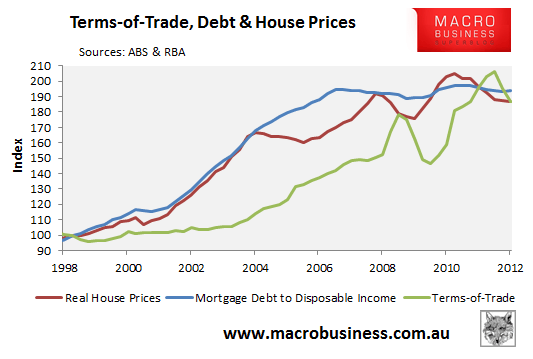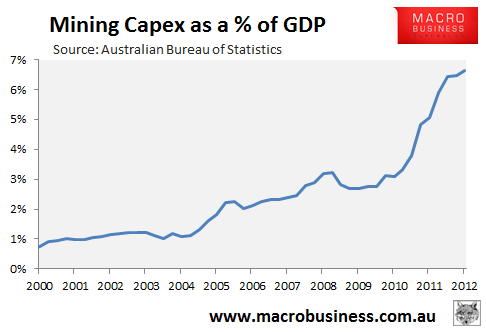Dr Nigel Stapledon, Associate Head of Economics at the University of New South Wales, gave the above interview on Friday afternoon on ABC News 24. In the interview, Dr Stapledon argues that Australia’s housing market was sparred a nasty correction in the mid-2000s by the once-in-a-century resources boom.
It’s a view that I agree with. As shown by the below chart, the extra disposable income generated from the commodity boom (as evident by the rising terms-of-trade) arrived just as the growth of mortgage debt was beginning to wane, enabling home prices in Australia to remain ‘stronger for longer’:
The huge increase in commodity prices was also supported by the surge in mining-related capital investment, from around 1% of GDP in 2005 to around 6.5% currently, with much of this growth experienced over the past two years (see next chart).
So, while rising housing debt was a key driver of Australian home prices up until 2004, as was the case in many other developed economies, strongly rising incomes from the commodity boom has played the predominant role since.
The flipside is that Australia could potentially experience a painful housing correction in the event that commodity prices experienced a sharp and protracted downturn, coupled with a deep contraction in mining-related capital investment. Were such an event to occur, it would likely cause big falls in disposable incomes, employment and government revenues as the terms-of-trade deteriorates and planned mining projects are cancelled, weighing on the entire economy (including the housing market).
Elsewhere in the interview, Stapledon notes that the significant increase in house prices had been a boon for the baby boomer generation, but that their wealth gains had come at the expense of the current generation of buyers. He also doesn’t see capital growth over the next 20 years being anywhere near what we have experienced over the past 20 years – instead expecting 1960s-style conditions – and warns that asset inflation will not ‘bail-out’ debtors like it had in the past. Stapledon also notes various constraints on housing supply – both infill and greenfield development – which has meant that shifts in demand tend to translate into prices rather than new construction.



